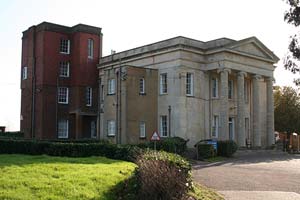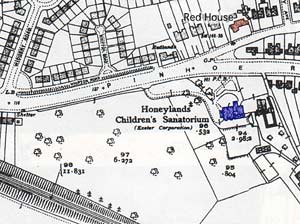
Honeylands House
Page added 26th June 2019
Just to the south west of Whipton Village, next to the Pinhoe Road is Honeylands House, a grand neo-classical structure fronted by four large Ionic columns topped by a simple pediment devoid of decoration, in Bath stone. The house, Honeylands, is now a pioneering Children's Centre that in the 1980s and 90s, did much to influence the care of children with learning difficulties across the country.
There has been a house on the site from before 1711 when, upon the death of Samuel Isaac, the owner of the Barton and Farm of Polsloe, it was sold by Act of Parliament to John Burgess, a tallow chandler. Elizabeth and Joanna, the daughters of John Burgess sold the house and grounds in April 1741 to Bartholomew Parr a doctor of medicine from Exeter.
The house passed from one occupant to another – Francis Brayne an apothecary leased the house, Charles Northcott purchased it in September 1747, and by 1756, Edward Bartlett a serge maker had purchased it. His son and grandson succeeded Edward. In the early 1800s one John Bussell, an attorney purchased the house and grounds. He was listed in the 1828 Besley directory as living at Honeyland, Wippen, with offices at Northernhay-lodge. Bussell was wealthy, as evidenced by a recent sale of a George IV mahogany bookcase, thought to have been from Honeylands, during Bussell's occupation. It was probably made by Gillows, sometime between 1820 and 1830. The sale notes suggest the house had been rebuilt by Bussell, giving it, by what had become in the early 19th Century, a Greek Revival makeover.
By the 1850s, it appears that the house was occupied by Frederick John Walker and later, James Sanders who was a “broker in hides and valonia” (valonia was made from acorns which were used in the tanning process). Tragically his wife died there, 7 day after his fifth child was born in Honeylands on 4 July 1856.
In 1860 George Speke purchased the house where he resided with his family. A tithe map of 1844 details the house as having three reception rooms, six bedroom, two servants rooms, stables, a coach house, laundry, farm buildings, and 47 acres. In addition, there were pastures, orchards and three other houses on the estate.
The Hare Family
James Hare, the owner of the Devon and Somerset Store in the High Street, purchased Honeylands for his family in 1883. He had married Jane having two sons and three daughters. Hare's business was flourishing, and along with a large house he could afford to advertise for a French or Swiss nursery governess for their growing family. One daughter, Mary, became well known across Exeter in the decade before the Great War for her interest in photography and recording many of Exeter's buildings. Hare died in April 1920, leaving his widow, and those unmarried children still at home, to sell Honeylands and move to the smaller Red House, just across the Pinhoe Road, in Whipton Village Road.
From family home to TB sanitarium
The house was sold to Mr Hamblin for £4,000, but unfortunately, he died in December 1922, before he had a chance to move in. A family member of the tobacco and cigarette makers, W D and H O Wills, Miss Violet Wills, who lived in Torquay, purchased the house, for £5,000, with the sole intention of donating it to the City Council for use as a sanatorium for children suffering from TB and other chest complaints. In the council minutes of January 1923, the Mayor, Councillor Steele-Perkins reported that more than 16 acres plus the house had been offered for the use as a sanatorium. It was estimated that it would cost £1,000 to repair and adapt the building, and that Miss Wills had offered to pay for the work. The Medical Officer of Health thought the house well suited, and that it could accommodate 20 young patients. Despite the City Architect stating the cost of refurbishment would be nearer £2,000, the offer was accepted and work commenced to open it as a TB sanatorium along with children suffering from scarlet fever and diphtheria. Visiting was only allowed on a Sunday and as part of their therapy, the children were expected to help in domestic duties, including work in the kitchen garden and cleaning the brass.
In 1960, after the decline of TB due to the introduction of antibiotics, Dr Frederick Brimblecombe a local consultant paediatrician, and Charles and Kay Vranch combined to open the Vranch House School at Honeylands for the Exeter Spastics Society. Brimblecombe, had a vision of opening a centre for children for the care of handicapped children, and was invited by the management committee to further develop Honeylands for this purpose. An extension was added to the house in 1968 funded from a £7,000 legacy from Miss Radford, and £12,000 from the League of Friends. The new facility was opened in 1971 by HRH the Duchess of Kent, was called the Brimblecombe Wing and had 30 beds. By 1973, when Miss Olive Petersen, the Matron retired, 200 children, aged from birth to 14 years old, were receiving therapy from 24 trained staff.
In 1990, a portable building was installed in the grounds for a toy library, partly paid for by the Royal Marines, who had staged a pantomime to raise funds. The Mayor, Margaret Midgely opened a £15.000 multi-sensory unit for children with severe learning difficulties in 1996. The centre was renamed the Honeyland's Children's Centre in 2005.
The centre is under threat of closure (2011) in its present form, with a consultation that suggests the care from Honeylands transferred to the Meadow Park Centre at Shillingford Abbot. Once the move has been made, Honeylands will be put on the market and sold for some other purpose.
Source: Isaac Estate Act HL/PO/JO/10/6/206/2744 National Archives, City Council minutes for 22/01/1923, Discovering Whipton, Express and Echo.
│ Top of Page │

